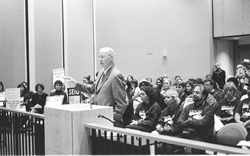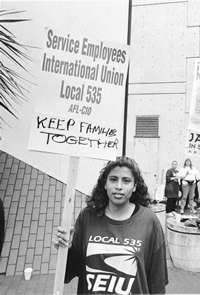Dragon Info
|
SF Children’s Social Workers Rally for Better Services
July-August 2001 The San Francisco Department of Human Services is not respecting workers and is endangering the well-being of the children and families of San Francisco, workers told the DHS Commission. Social workers testified before the commission and rallied in front of the San Francisco social services building on July 26. According to union field representative Linda Joseph, the union has been meeting with management to resolve a grievance around the department’s restructuring into multi-functional units, but management has reneged on several agreements and is acting in bad faith. “We want to find a solution that will allow workers to provide services to kids and families, and management is not being serious about it,” she says. Recent federal regulations have shortened the time emergency
response workers have to respond to a complaint and have increased the
documentation workers must fill out, Joseph explained. To make up for
the added work and speedup, management agreed to increase the number of
workers. Management, however, never made good on the promise. When the
issue of hiring more workers was brought up, management proposed hiring
an independent contractor to supervise family visits and told the union
they had no intention of negotiating staffing issues. This is at a time
when caseloads in some units are as high as twice the statewide average.
According to Joseph, instead of hiring more line workers, the department
is hiring more managers and spending money on projects that don’t
involve case-carrying workers. The situation reached a crisis point two years ago with
the creation of multi-function units, which combine emergency response,
court dependency, and family preservation units. The restructuring exacerbated
one of the welfare agencies greatest problems. Workers have been complaining
that new workers are not properly trained when they start the job and
supervisors lack the expertise to train them. The creation of multi-function
units took this problem and multiplied it by three: instead of having
to bluff one’s way through one job, workers and supervisors have
had to stumble around trying to learn three. What really upsets the workers is that families and
children are suffering because of mismanagement. As child welfare worker
Dan Phillips explains, before the multi-function units, emergency response
workers were able to keep families together by offering family preservation
services. An ER worker could assess a problem in a home, but instead of
traumatizing the family by removing the children and bringing them into
the system, the parents could be helped through voluntary family preservation
services. Family preservation programs can be very effective for everyone involved. They save parents and children the trauma of being separated from each other and save the county the cost of court proceedings and expensive foster care. Workers are able to spend time providing services rather than filing court papers. It is also much less cumbersome to provide voluntary services, because once the child is in the system, it becomes a legal contest. As Craig McCracken explains, “San Francisco is one of the most litigious counties. Attorneys for the parents act like having services ordered for a family is the same as finding them guilty of a crime.” The problem with combining emergency response with family preservation and the court is that workers are forced to make court work the priority. “Given the choice between providing voluntary services to a client and risking being found in contempt of court because you didn’t do your court work, guess what is going to give,” McCracken states. The result is that workers are not able to provide voluntary services and instead they are having to bring children into the system who might otherwise have been helped at home.
|
||||||



